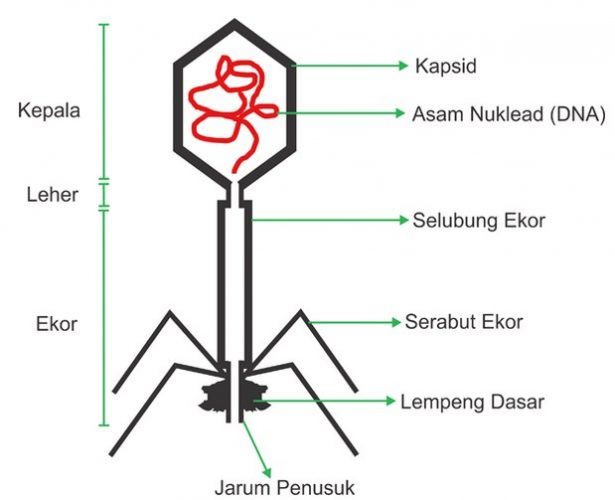Virus
Education The virus chapter that discusses the understanding of viruses, virus structure, classification, various viruses, history of viruses and viruses, For more details, the discussion below

Understanding Viruses
“Virus namely microscopic parasites that infect cells of biological organisms”
Viruses have obligate parasitic properties, this is because the virus can only reproduce in living material by invading and utilizing living cells, because the virus does not have the cellular equipment to reproduce itself.
The virus generally contains a small amount of nucleic acid which is covered with a protective material consisting of protein, lipid, glycoprotein, or a combination of all three. Viral genomes can be expressed into both proteins that are used to contain genetic material and protein needed in their life cycle.
The term virus generally refers to particles that infect eukaryotic cells (multicellular organisms and many types of single cell organisms), while the term bacteriophage or phage is used for types that attack prokaryotic cell types or bacteria and other cellless organisms
Viruses are often debated as living things because they cannot carry out their biological functions freely if they are not in the host cell. Because of this characteristic, viruses are associated with certain diseases, good for humans, animal or plant
Etymology
The word virus comes from Latin viruses which means' poison’ and other dangerous liquids.
Definition & ldquo; agents that cause infectious diseases” first used in years 1728, before the discovery of the virus by Dmitri Ivanovsky in years 1892.
Various kinds of viral infections
The virus can infect its host and cause various consequences for its host. something is dangerous, but there are also those that are able to be handled by immune cells in the body so that the resulting effect is not too big.
Acute infection is an infection that lasts for a short period of time but can also be fatal. As a result of acute infection, i.e.:
- recover without damage or total recovery
- recover with damage or disability, for example polio
- continues with chronic infection
- Dead.
Chronic infection is a prolonged viral infection until there is a risk that the symptoms of the disease will reappear. Examples of chronic infections, i.e. :
- silent subclinical infection for life
- silent period long enough before the emergence of the disease, for example : HIV
- reactivation causes acute infections, for example : shingles
- chronic recurrent disease (relapse), for example : HBV, HCV
- cancer, for example : HTLV-1, HPV, HBV, HCV, HHV.
Virus Structure
The body shape of the virus varies, some have a ball-like shape, tube, prism and letter T (for example bacteriophage). Bacteriofage is a virus that attacks bacteria. For the body structure of the virus consists of

1. Skin
The virus has a skin or wrapper called capsid. The capsid is a protein shell that wraps the viral genome, can be rod shaped, polyhedral, or in other more complex forms. The capsid itself is composed of protein units called capsomeres, but the amount of protein in different capsid is small.
In viruses that attack animals on the outside of the capsid there is a special wrapper called the membrane lipoprotein. In tobacco mosaic virus has a rigid capsid structure as well as a trunk-like structure composed of more than a thousand molecules of a single type of protein that forms helices. for this reason, viruses that have a rod shape are called helical viruses.
Viruses that infect the respiratory tract in animals, including the type of Adenovirus virus. This virus contains about 252 identical protein molecules that are arranged and form a polyhedral capsid with 20 triangular side of an icosahedron. This is why adenoviruses and other viruses of similar nature are called ikosahedral viruses.
Some viruses have accessory structures that help the virus infect the host. For example, the membranous envelope that surrounds the capsule of influenza virus and many other viruses found also in animals. Viral envelope or viral envelope, originating from the host cell membrane, contain phospholipids and also host cell membrane proteins. Envelopes also contain proteins and glycoproteins from viruses.
Most of the most complex capsids are found in viruses that infect bacteria, which is called bacteriophage.
2. they
Genetic material (nucleoprotein) also called the core ingredients that make up the body the virus consists of :
- a. AND, exist in viruses that live in animals
- b. ARN, exist in viruses that live in plants
- c. AND or ARN, exist in viruses that live in bacteria.
For respiration, viral cells do not have mitochondrial organelles, and viruses also do not have ribosomes for protein synthesis. But viruses contain genetic information that can be used to synthesize proteins if they are present in the host body, capsid is used for the synthesis of enzymes that function in taking over the metabolic processes of host cells. And to self-replicate using its nucleic acids.
History of discovery
Viruses have infected since before BC, it was proven by the existence of several findings, namely reports about viral infections in hieroglyphics in Memphis, the capital city of ancient Egypt which showed the existence of poliomyelitis. other than that, The king of Pharaoh Ramses V died in the year 1196 SM and is believed to have died from the smallpox virus.
In pre-AD, The endemic virus is quite well-known by the name of the smallpox virus which invaded Chinese society years ago 1000. The year on 1798, Edward Jenner found that some milkers have immunity against the Pox virus. It was suspected because of the Pox virus found in cows, protect humans from POX. The discovery was understood to later become a pioneer in the use of vaccines.
Year 1880, Louis Pasteur and Robert Koch presented & ldquo; germ theory” namely that microorganisms are the cause of disease. At that time also famous Koch Postulate which is famous today:
- Disease agents must be present in every case of disease
- Agents must be isolated from the host and can be grown in vitro
- When the culture of the muri agent is inoculated in susceptible healthy host cells, it can cause disease
- The same agent can be taken and isolated again from the infected host
This is what the virus talks about, May be useful
Another article :
- Magnetic field : Character, Understanding and Formulas
- Mahraj Huruf Hijaiyah : Hijaiyah Letters and Exits
- Examples of Tafkhim and Tarqiq along with the Definition and Number of Qalqalah Letters
The post Virus appeared first on this page.